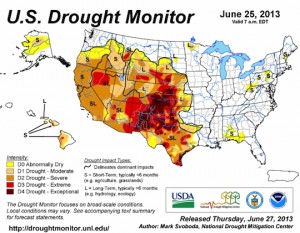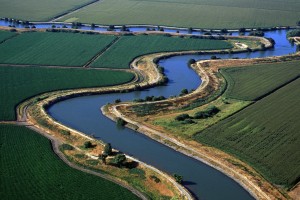The Sweltering West: Water Scarcity and California’s Delta Boondoggle
Jul 2nd, 2013 | By admin | Category: Water IssuesBy Suzanne York, www.howmany.org.
As the U.S. west and southwest endures extremely high temperatures and record-breaking drought, the issue of providing water to still growing cities and regions should be at the top of the agenda.
Tuscon has sweltered through 100 degree temperatures the entire month of June. Las Vegas hit 117 degrees, tying its all-time record. The latest U.S. drought monitor, below, reflects the heat crisis in the region. (And lest you think it’s only the southwest undergoing record heat, Alaska also set record highs in June.)
Drought or not, water is precious in the arid west. In California, Governor Jerry Brown’s plan to address water needs is to divert water from the Sacramento-San Joaquin Bay Delta to Southern California via two 40-mile-long tunnels to existing pumps and aqueducts. Most of the cost would be paid for by water users. A bond measure, set for 2014, would be for $11 billion to restore 100,000 acres for habitat restoration. That is, if voters approve it.
The Center for Biological Diversity (CBD) states that this solution will further harm the smelt and other wildlife that depend on the Delta. The environmental organization is advocating that people to take action by calling state and federal agencies to protect endangered species and reject the Delta Plan and its twin tunnels – a $25 billion project – now incorporated into the Delta Bay Conservation Plan.
According to CBD, just a few reasons to oppose the tunnels include:
- Will be destructive to the environment and harm endangered species;
- Are too large and encourage mismanagement;
- Do not prevent the South Delta pumps from being used, causing additional entrainment of Delta smelt;
- Put our local fresh water supplies at additional risk by moving the salinity barrier even farther east in the Bay Delta.
As policymakers, academics, activists, agriculturalists, and others contemplate this project, they need to keep in mind more than just the $25 billion price tag (though that’s hard to not think about). How is the water being used? What is the true “state of water” in California? Will the Delta ecosystem really be protected? What about population growth in the face of resource shortages, especially of water?
The state of California (and the U.S. southwest) can choose whether it makes sense to support water-scarce cities and sprawl or pull back, in the face of climate change and population growth, and design a water strategy that sustainably balances the demands of all users as Californians face the challenges ahead together.
Temperatures over 100 degrees certainly make you think about the best choices to make for the environment and communities.
Suzanne York is a senior writer with the Institute for Population Studies.


